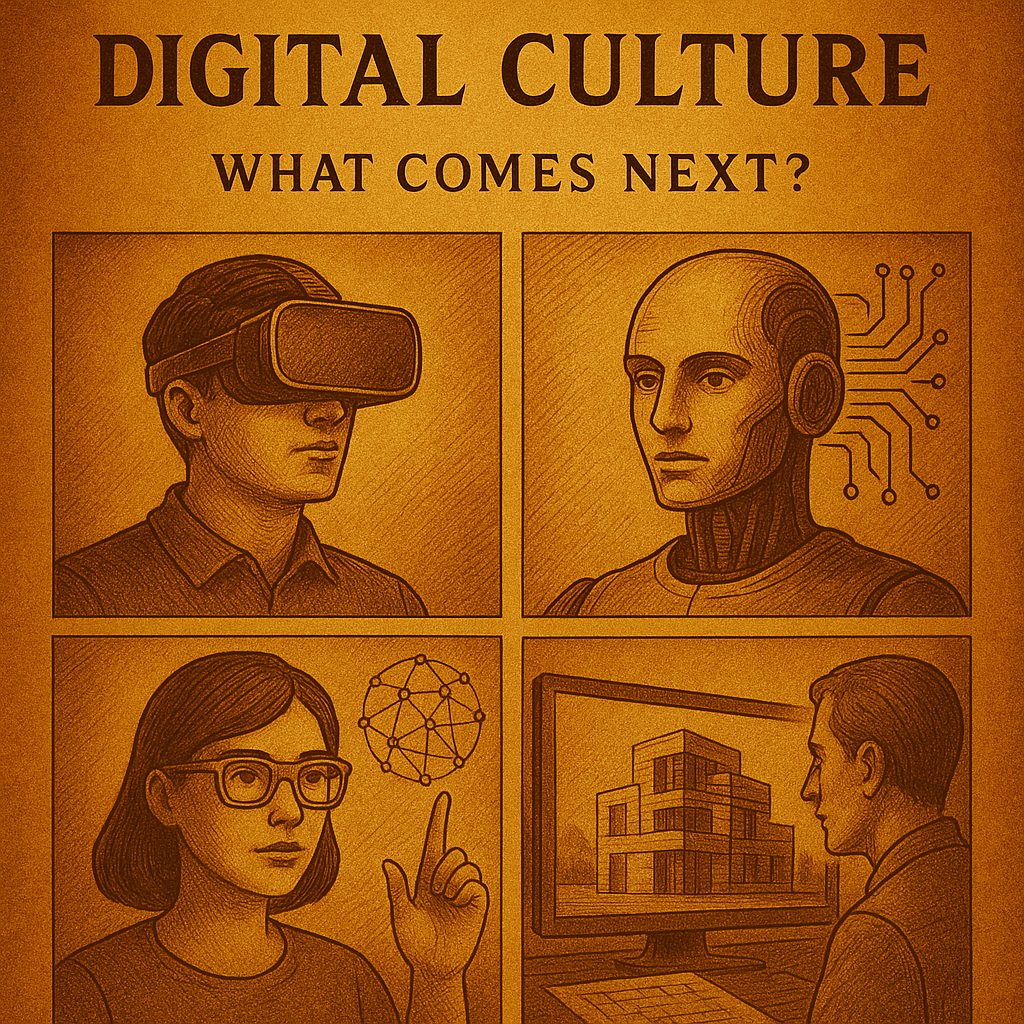Your cart is currently empty!

The Future of Digital Culture: What Comes Next?
Introduction: Understanding Our Rapidly Changing Digital World
Today’s society is more digital than at any other point in history. From the clothes we wear that can track health data to the cars we drive equipped with smart navigation systems, our physical environment is increasingly shaped by digital innovation. This transformation is not limited to internet-connected gadgets like thermostats and security cameras; it represents a deeper cultural shift, where the line between the digital and physical worlds is becoming increasingly blurred.
Every day, we immerse ourselves more deeply in this digital ecosystem. Social media platforms shape our communication, artificial intelligence powers our decision-making tools, and cloud systems store our collective memory. In such an environment, predicting the future of digital culture is both fascinating and challenging.
New technologies arrive at an astonishing pace. Each innovation, from blockchain to immersive reality systems, forces us to rethink how we live, work, and connect with others. These shifts create both opportunities and risks, particularly as digital technologies begin to reshape our cultural values and social interactions.
One of the central questions for the future of digital culture is not whether it will evolve but how it will evolve. Will our society embrace a fully immersive digital experience, or will there be limits imposed by ethical, social, or political concerns? The answers remain uncertain, but the trajectory clearly points toward deeper integration between technology and daily life.
This article explores several key areas of innovation—virtual reality, artificial intelligence, augmented reality, and digital transformation of the physical world—providing insights into how these changes may shape the culture of tomorrow.
Virtual Reality: Where Is It Headed?
Virtual reality (VR) once carried the promise of becoming the dominant platform for entertainment and communication. A decade ago, many believed VR would replace television, cinema, and even classrooms. Yet the reality has been more modest. While VR has transformed gaming and niche training industries, its mainstream adoption has not matched early predictions.
One reason for this slower growth is accessibility. VR headsets remain expensive, bulky, and often uncomfortable for long-term use. Many consumers view VR as a novelty rather than a daily tool. However, this perception may change as hardware becomes more refined and affordable, making VR more practical for broader applications.
Beyond gaming, VR offers vast potential for education, healthcare, and workplace collaboration. Universities already experiment with VR classrooms, while surgeons train on simulated procedures to reduce real-world risks. Corporations use VR for remote team-building and product testing, highlighting its potential beyond entertainment.
Tech giants like Apple, Meta, and Google continue investing heavily in VR research, signaling their belief in its long-term potential. Apple’s Vision Pro, for example, reframes VR not just as an entertainment device but as a platform for productivity, creativity, and immersive learning.
The future of VR will likely combine entertainment, professional training, and social interaction into one seamless ecosystem. While adoption may be gradual, VR is positioned to become a significant cultural force that reshapes how humans experience reality.
Artificial Intelligence and Machine Learning: What Comes Next?
Artificial intelligence (AI) and machine learning (ML) are the engines driving today’s digital transformation. From managing our daily schedules to enabling self-driving cars, AI, and ML underpin the technologies that make digital culture possible. They have shifted from academic concepts to essential components of everyday life.
At their core, AI and ML serve different functions but are deeply interconnected. AI is the overarching concept of machines simulating human intelligence, while ML is the process by which these systems learn and improve through data. Together, they enable personalization, automation, and efficiency in almost every sector.
Currently, AI excels at narrow tasks. It can process vast amounts of data, recognize patterns, and make recommendations. However, it still struggles with general intelligence—the ability to reason like humans across multiple domains. Experts debate whether such “artificial general intelligence” will ever be possible, yet research continues to push boundaries.
The near future of AI and ML likely lies in greater integration across industries. Healthcare systems will use predictive algorithms to anticipate diseases, education platforms will personalize learning for each student, and finance will increasingly rely on AI-driven decision-making. These applications will enhance productivity and efficiency but also raise questions about ethics, bias, and transparency.
As AI and ML continue to advance, society will need to develop frameworks for responsible innovation. The challenge is to balance progress with safeguards, ensuring these technologies enhance human life without creating new inequalities or risks.
Augmented Reality Will Become Incredibly Sophisticated
While VR immerses users in fully digital environments, augmented reality (AR) enhances the real world with digital overlays. This technology has already captured global attention, from Pokémon Go’s massive popularity to AR filters on social media platforms. Yet AR’s potential extends far beyond entertainment.
AR allows users to layer information onto the physical world. Architects can visualize buildings in real spaces before construction, surgeons can see digital overlays during operations, and travelers can access real-time translations projected onto street signs. These applications demonstrate AR’s potential to reshape both professional and personal experiences.
Advances in computing power and mobile devices make AR increasingly sophisticated and accessible. Unlike VR, which often requires expensive equipment, AR can be delivered through smartphones and lightweight wearables. This accessibility positions AR to become more mainstream in daily life.
Major corporations are racing to dominate AR technology. Apple, Google, and Microsoft invest billions into developing AR platforms, betting that AR glasses will eventually replace smartphones as our primary digital interface. If successful, AR could redefine how humans interact with information.
As AR evolves, it may become seamlessly integrated into our surroundings. Instead of pulling out a phone, people may rely on AR glasses to navigate cities, attend virtual meetings, or interact with digital art in public spaces. This sophistication will make AR not just a tool but a cultural shift in how we perceive reality itself.
Our Physical World Will Be Digital Too
Digital transformation does not stop with entertainment or communication. Increasingly, our physical environment is becoming digitized. Architecture, manufacturing, and design industries already rely heavily on digital tools, changing how our cities and homes are planned and built.
Digital design platforms allow architects to collaborate remotely with clients and engineers, dramatically reducing costs and improving efficiency. Complex projects that once took years to design can now be modeled and simulated digitally within weeks. This accelerates innovation while ensuring greater precision and safety.
The rise of 3D printing further transforms the physical world. From printing medical implants to constructing entire homes, 3D printing enables the translation of digital blueprints into tangible reality. This convergence of digital design and physical creation may revolutionize manufacturing, logistics, and even personal lifestyles.
Moreover, industries are increasingly adopting digital twins—virtual models of physical systems that allow real-time monitoring and problem-solving. Cities can simulate traffic patterns, factories can predict machine failures, and hospitals can model patient outcomes before administering treatments.
Ultimately, the digitization of the physical world represents one of the most profound cultural shifts of our time. As the boundary between digital and physical collapses, humanity will enter a new era where innovation happens both in virtual spaces and in the tangible environments we inhabit.
Conclusion: Embracing the Future of Digital Culture
The future of digital culture is dynamic, uncertain, and filled with possibilities. From immersive virtual reality to powerful artificial intelligence, from augmented reality overlays to digitalized physical environments, technology continues to redefine how humans live, work, and connect.
These shifts are not merely technological but cultural. They influence how societies organize knowledge, create meaning, and maintain relationships. Digital culture is becoming the new framework through which humanity interprets the world.
Yet, as with any cultural transformation, challenges remain. Ethical dilemmas, privacy concerns, and questions about equality must be addressed if these technologies are to serve humanity rather than exploit it. A thoughtful balance between innovation and responsibility is essential.
By staying informed and critically engaged, individuals and societies can shape digital culture in ways that align with shared values and goals. This requires active participation, not passive consumption.
The digital future is coming—indeed, it is already here. The task before us is not only to predict it but to guide it wisely, ensuring that technology enhances the richness of human life rather than diminishing it.


Leave a Reply